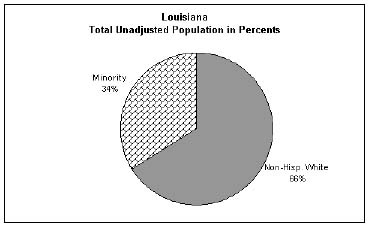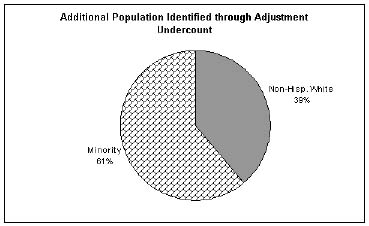State-by-State Analysis: Louisiana
The
1990 undercount and its demographic composition
As
indicated in Table 1, the percentage undercount of 2.2 percent in Louisiana
was higher than the national average of 1.6 percent and resulted in a net
numerical undercount of 94,112 persons, tenth highest in the nation. For
non-Hispanic whites, Table 1 indicates, the undercount percentage was 1.3
percent, as compared to 4.0 percent for members of minority groups. As indicated
in Table 2 and the summary Chart below, these differentials between whites
and minorities resulted in an undercounted population with a much greater
minority group percentage than the state's total population. Minorities
comprised 34 percent of the state's uncorrected population, compared to
61 percent of the state's undercounted population. In numerical terms, the
undercount consisted of 36,725 non-Hispanic whites and 57,387 members of
minority groups. In Louisiana, minority group members are primarily non-Hispanic
blacks. According to corrected data, 89 percent of minority group members
in Louisiana are non-Hispanic blacks, 7 percent are Hispanics, and 4 percent
are members of other minority groups.


Implications
of 1990 Census adjustment for minority voter opportunities
The use of
corrected data in Louisiana for the post-1990 redistricting would have had
the potential to enhance minority voter opportunities in the plans drawn
for the State House. In the Louisiana State House, the use of corrected
data would have increased the baseline of majority-minority districts. State
House District 98, located in the New Orleans region in the post-1990 plan,
includes a minority population of 49.4 percent. However, application of
the corrected data for 1990 demonstrates that the population of this District
is more accurately measured at 50.2 percent.





